We Communicate For Happy Children
 The genocide in Gaza from a gender perspective and the impact on early childhood
The genocide in Gaza from a gender perspective and the impact on early childhood 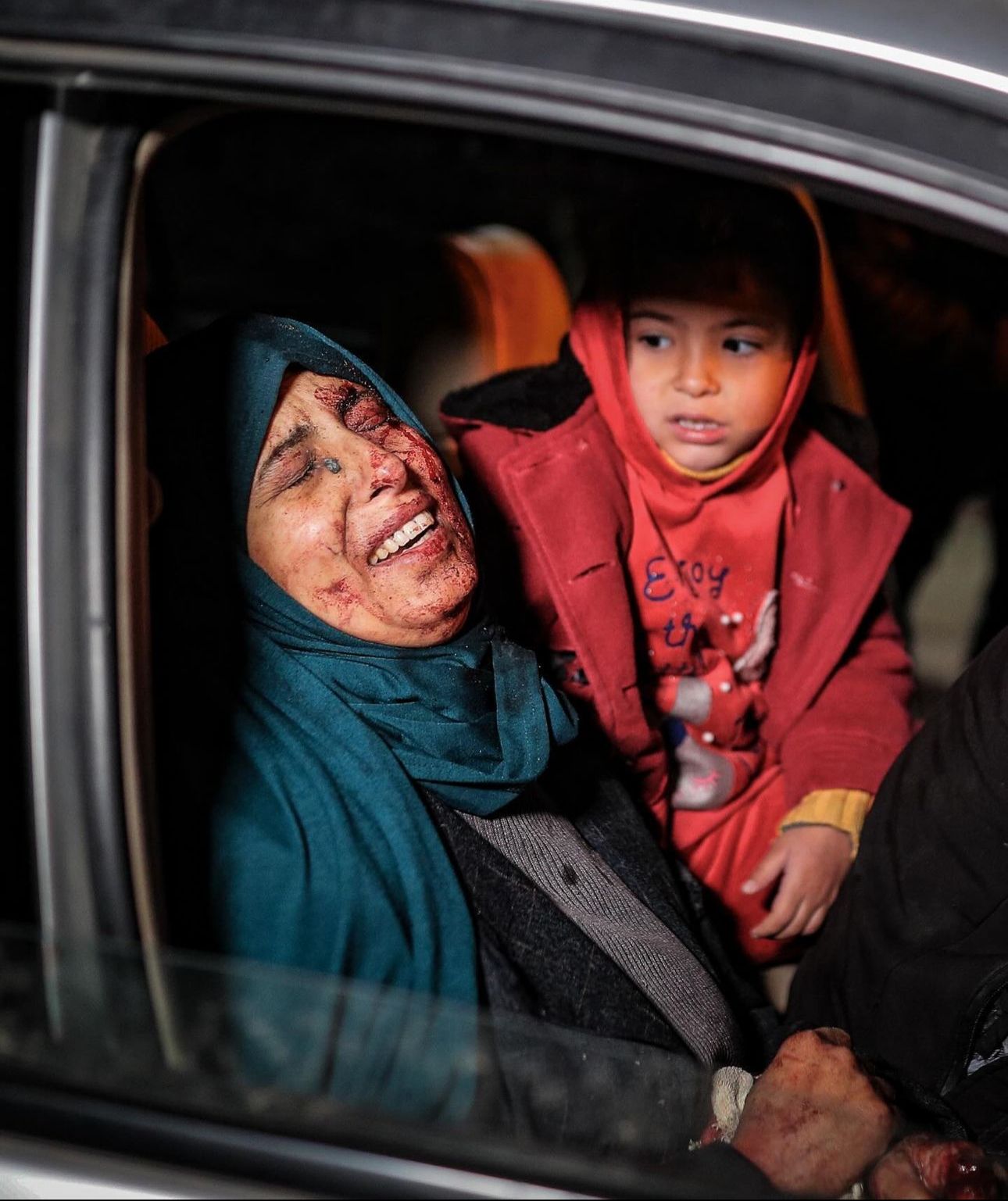
It is not possible to follow the Israeli genocide in the Gaza Strip and its impact on early childhood without studying its effects from a gender perspective. According to this perspective, which includes traditional social roles and other factors caused and reinforced by the Israeli occupation, the results and consequences of war vary. More than 70% of the victims of the current war on the Gaza Strip are women and children. International humanitarian institutions described Gaza as becoming a cemetery for women and girls, and international bodies, led by the United Nations Women’s Affairs Committee, considered that the war on Gaza was a war on women. The war on women includes the environment surrounding the child, including mothers, caregivers, pregnant women, and breastfeeding women. It also places an additional burden on providers and caregivers of children based on the traditional social role of the provider. As the Israeli genocide in the Gaza Strip exceeds its seventh month, specialised reports and studies are increasing, issued by local, regional, and international institutions and research centres, which address the repercussions of the war from a gender perspective. What does the impact of war look like from this perspective? What are the horrific repercussions for women and girls in particular, and how do they relate to the early childhood sector as a whole?
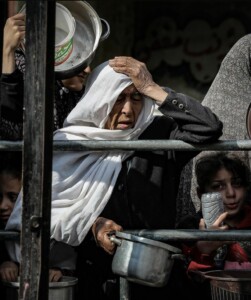 Photo source: Belal Khaled
Photo source: Belal Khaled
The war on women and gender protection
According to estimates by the United Nations Women’s Affairs Committee in early April, the Israeli war, six months after it began, killed more than 10,000 women in Gaza, including about 6,000 mothers, leaving behind about 19,000 orphan children. These estimates came at a time when the number of martyrs in the Gaza Strip was 33,207, according to the Palestinian Ministry of Health. While the number of martyrs today, after seven months of war, exceeded 35,000 according to the “Palestinian Central Bureau of Statistics,” and 42,000 according to the “Euro-Mediterranean Human Rights Monitor,” and the number of missing women and children is 4,700, the number of women and mothers who were martyred, and hence the orphans has risen since then. (On May 1, the Palestinian Civil Defence reported that there were more than 10,000 missing people under the rubble. On April 10, the Euro-Mediterranean Human Rights Monitor reported that there were 13,000 Palestinian children.)
Also in numbers, the United Nations Women’s Affairs Committee reported in January of this year that two mothers in the Gaza Strip are martyred every hour. The Committee’s statistics were based on the number of women martyred in the Gaza Strip, according to the Office for the Coordination of Humanitarian Affairs (OCHA), issued on December 8, 2023, which reported at the time that 5,153 women had been martyred. Adopting the same equation, calculations based on the martyrdom of 10,000 women until April 9, 2024, indicate that one woman is martyred every hour in the Gaza Strip. The rate has likely increased by the date of the report’s issuance.
In this context, the Euro-Mediterranean Human Rights Monitor stated, on the 200th-day remembrance of the Israeli war, that “Israel kills 79 children and 50 women every day, which are terrifying and unprecedented numbers in the context of contemporary wars.” According to this toll, three children and two women are martyred every hour. This comes while most of the injured are unable to obtain the necessary treatment and medical care. The number of wounded people exceeds 82,000, including at least 11,000 critical cases that require travel to receive treatment in light of Israel’s destruction of the health sector in the Gaza Strip.
The above are not just unfortunate numbers; the increase in the number of deaths of parents and the change in the pattern of loss of life monitored by the United Nations will affect the dynamics of power and gender-based relations, as these dynamics are linked to traditional social roles. The effects of this change on childhood are also connected to the traditional role of the breadwinner in Gaza, which places the responsibility on the woman for household tasks and providing care for the children, while the man is required to support the family financially (without necessarily limiting them to that). This comes at a time when a large number of women, including elderly women, have become breadwinners for their families and are exposed to obstruction, danger, and inequality when trying to obtain aid.
In this context, the United Nations Women’s Affairs Committee explains that “the loss of parents or breadwinners leads to changes in family composition, such as a shift from nuclear families and predominantly extended families to very extended families. In light of this, women fear that given food shortages, school closures, and loss of educational opportunities, families will resort to desperate coping mechanisms such as early marriage, especially in light of the increase in the number of young girls who have lost one or both parents.”
The Committee concludes that women and girls are exposed to additional disadvantages due to gender-based inequalities in access to supplies, services, and resources. This applies, in particular, to families headed by women, whose numbers are increasing with the rise in the number of martyrs among male breadwinners.
It also shows that there are currently no safe spaces for survivors of gender-based violence that are working sufficiently. As the war continues, tensions within families and communities increase, which in turn raises concerns about gender-related protection risks, including gender-based violence.
In this context, the change in the pattern of loss of life recorded by the United Nations from 14% being women and girls martyred between 2008 and October 7, 2023, to 70% being women and children after this date, meaning that the child home caring tasks are transferred either to the man within the family or to the extended family. This may pose potential risks for girls in particular and difficulties for the father.
While initially a small number of women in Gaza had an income before the war, this group has become even smaller, as a number of women who work from within the home have lost their workplaces due to the destruction of housing units.
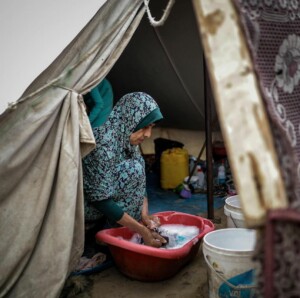 Photo source: Belal Khaled
Photo source: Belal Khaled
Captivity and torture
While Palestinian women in Gaza live in the worst conditions, women and mothers from the Strip are subjected to campaigns of arbitrary arrests. The “Palestinian Prisoners Society” issued a fact sheet on the eve of “Palestinian Prisoner Day” on April 17, 2024, in which it indicated that the data it provided about the number of female detainees does not include “female prisoners from Gaza who are detained in detention centres.” This is due to the difficulty of counting numbers in light of the continuing war and enforced disappearance.
Female prisoners are subjected to severe violations. In this context, local and international institutions indicate that they have received dozens of testimonies from released prisoners and detainees, including women and children, about their exposure to unprecedented types of violations and beatings, including torture leading to death, denial of treatment and leaving distinct scars, physical nudity, harassment and sexual violence.
The Euro-Mediterranean Human Rights Monitor documented that female detainees from the Gaza Strip, including mothers, were subjected to sexual violence, torture, and inhuman treatment through nudity, sexual harassment, and threats of rape, in addition to being constantly threatened with deprivation of seeing their children. The Euro-Med Monitor explained that arriving at the exact number or actual dimension of the extent of these violations against Palestinian women and girls if achieved, is likely to take longer.
The bitter suffering of displacement also has a different impact, in many ways, depending on gender. While the majority of the population has been subjected to internal forced displacement, amounting to more than two million people, and many of them have been displaced multiple times -many on foot- women, mothers, pregnant and lactating mothers, and caregivers are exposed to the risk of arbitrary arrest and harassment during displacement, and being deprived of their children for long periods of time, which has a tremendous psychological and caregiving impact on the child and for the person to whom the responsibility of providing care is transferred. The social role is also reflected in the issue of displacement in many cases, as “the women in the family are often the ones who stay with relatives, the elderly, or individuals with disabilities who cannot move.”
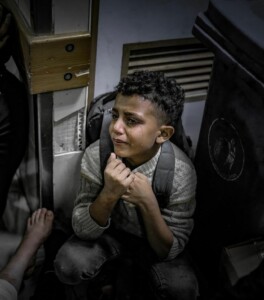 Photo source: Belal Khaled
Photo source: Belal Khaled
The impact of “scarcity of resources and fear” from a gender perspective
In light of the deteriorating health conditions, the spread of epidemics and diseases, and the high number of deaths as a result, the water and sanitation crisis and their close connection to physical health and hygiene headline the list of the most prominent crises that document gender-based inequality. In an analysis entitled “Scarcity and Fear”, as part of a series of publications related to gender, UN Women draws from the limited access of women and girls to water, sanitation, and hygiene services to highlight the gender impact.
The water crisis in Gaza predates the current war. In a study delving into the effects of the 2023-2024 war on water and health in Gaza, the Geneva Water Hub points out the harmful and cumulative effects on water and sanitation services of the wars launched by Israel in the Strip during the past years. It explains that most of the water pumped from Gaza’s aquifer is unfit for drinking due to very high levels of nitrates, chlorides, and salinity. According to UN Women, access to water in the Strip had already been limited for an extended period before October 7 as a result of decades of Israeli occupation.
Indeed, water-related diseases were reported as the leading causes of illness among children in the Gaza Strip before the current war.
However, the current genocide has compounded the tragedy. According to the UN Women’s Report, the level of water supply in the Gaza Strip reached 7% compared to before October 7. People in Gaza are also resorting to using salty agricultural wells that are 30 times more saline than regular water, which increases the risk of immediate health repercussions, especially for infants, pregnant women, and kidney patients. To compound the tragedy, chlorine and other commodities that would make the water safe to drink and restore the sanitary conditions effort remain on the ‘rejected’ list of items Israel allows aid agencies to bring into Gaza. Deliveries even of bottled water continue to be denied by Israeli authorities, especially to northern Gaza, according to the Geneva Water Hub.
The effects of this reality on young children are devastating. Currently, there are more than 337,000 girls and boys under the age of five in Gaza who are particularly at risk of contracting waterborne diseases. In this context, the Geneva Water Hub raises the issue of the danger of drinking water blending with sewage and its effects, speaking about the most concerning diseases resulting from this, including diarrhoea (such as dysentery), enteric fever (such as typhoid), and acute jaundice syndrome (such as hepatitis A), and skin conditions such as scabies and lice.
Women and girls disproportionately and unequally feel the impact of inadequate water and overall personal hygiene. This category faces unique challenges when accessing scarce water resources. In this context, the “Scarcity and Fear” report warns that women and girls face an increased risk of exposure to hepatitis A due to their traditional caregiving roles, including sick family members. Also, 91% of women, including mothers, pregnant women, and caregivers, are unable to meet their personal hygiene and menstrual cycle-related needs.
According to figures from the United Nations Population Fund, there are more than 690,000 women and adolescent girls of menstruating age inside Gaza, all of whom face limited access to menstrual hygiene products, in addition to a lack of water, sanitation, and personal hygiene facilities.
Access to clean water and appropriate food is crucial, especially for breastfeeding and pregnant women, who need to consume larger amounts of water and calories daily than others.
According to the United Nations Development Programme (UNDP), pregnant and breastfeeding women need 7.5 litres per day to maintain their and their children’s health, equivalent to five times the amount of water currently available. According to humanitarian standards, the minimum amount of water required in emergency situations is 15 litres, including drinking, washing, and cooking water. To survive, the minimum is estimated at three litres per day.
However, pregnant and lactating women in the Gaza Strip face serious difficulties in this context, as women suffering from dehydration will struggle to produce the milk they need to feed their children and keep them alive. The United Nations Women’s Affairs Committee quotes a doctor from Khan Yunis, in the south of the Gaza Strip, who said that many women reported facing difficulties during breastfeeding and that infants who cannot breastfeed – due to the mother’s inability or her death (or martyrdom) – are forced to use formula (industrial milk) are particularly vulnerable due to the need to use clean and safe water, which is currently rarely available in Gaza.
As food security increases to unprecedented levels, women and girls are expected to be the most affected, as women tend to reduce their food intake to a greater extent when access to food is restricted, according to the United Nations. Despite the tragic reality of women, mothers, breastfeeding mothers, caregivers, and girls in Gaza, only a very small percentage, 0.09%, of funding through the Flash Appeal was directed to national or local women’s rights organisations in Gaza.
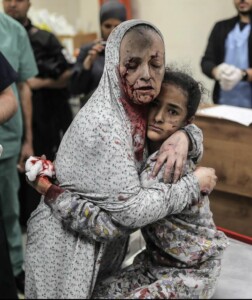 Photo source: Belal Khaled
Photo source: Belal Khaled
Rafah: Women and girls waiting for death and despair
With the Israeli occupation army announcing the start of a ground incursion east of the city of Rafah, south of the Gaza Strip, and the arrival of its tanks to the Palestinian section of the Rafah crossing, 700,000 women and girls there find themselves without a safe place.
Data from a survey conducted by UN Women from Rafah and published on May 6, 2024, show that the physical and mental health conditions of women and girls have deteriorated significantly, and their suffering has deepened. 93% of the women surveyed expressed their feelings of insecurity, while more than half of the women interviewed reported critical health conditions that required urgent medical attention. UN Women warned that any ground invasion would raise these numbers.
In addition, more than 6 out of every 10 women who are currently pregnant or who have become pregnant since October 2023 reported health complications, some of which were critical. Also, 72% of breastfeeding women reported challenges in breastfeeding and meeting the nutritional needs of children.
The Israeli army is working to displace civilians from the eastern neighbourhoods of Rafah to what Israel considers a newly expanded “humanitarian zone” in Al-Mawasi to the west. This comes as Rafah receives more than half of Gaza’s population after its inhabitants numbers increased fivefold since the start of the war.
